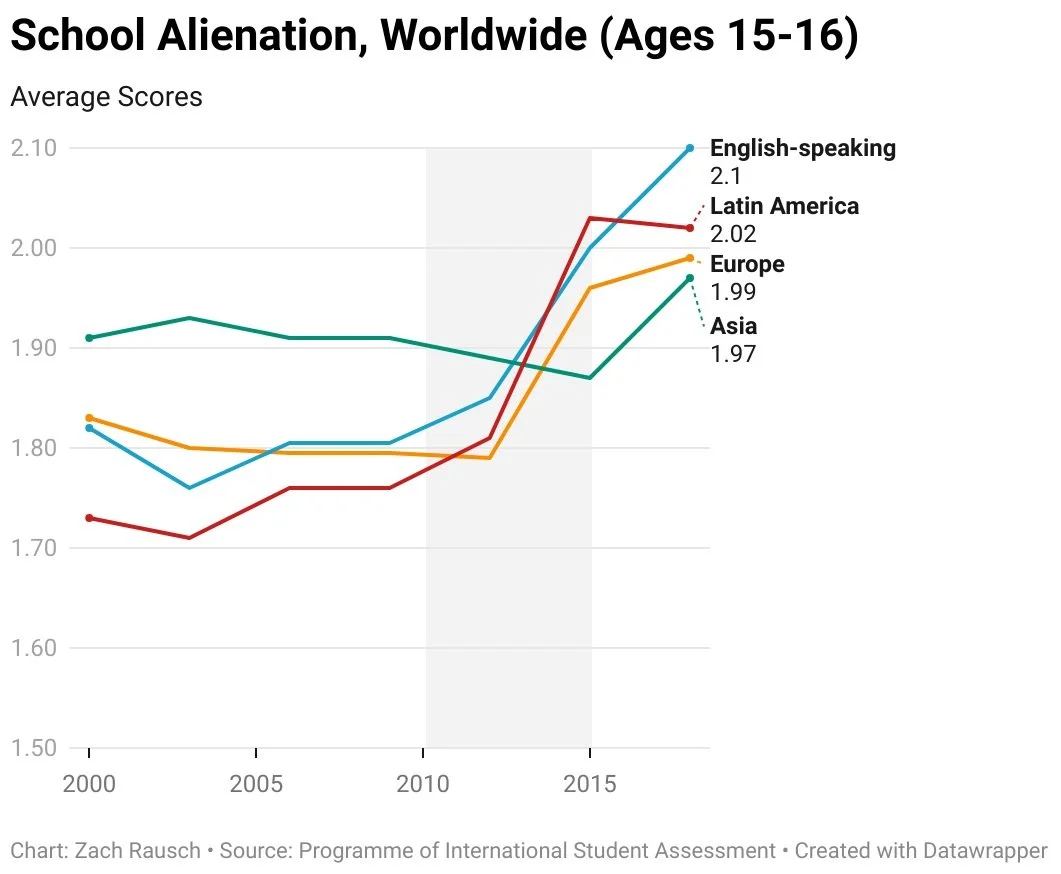
School Leaders,
Start Here!
ScreenSense helps schools keep tech in check so students learn, connect, and thrive in real life.
The impact of tech overuse in childhood is a collective problem affecting families, schools, and communities. Therefore, we need all hands on deck to collectively adopt a more sustainable approach to all this digital tech in our lives. Schools are a key driver for community change. Our hope is for schools to cultivate a healthy, intentional relationship with digital tech that supports (rather than disrupts) face-to-face connections, critical thinking, attention, and learning.
What’s the problem?
Average screen time is increasing and crowding out in-real-life activities that we know are essential to develop children’s attention spans, emotional regulation, executive functioning, and social skills.
Sources: Common Sense Media, 2025, ages 0-8; Common Sense Media, 2021, ages 8-18.
Meanwhile, academic outcomes have worsened globally in reading, math, and science. Reading scores peaked in 2012, and have steadily fallen since then - partly because scrolling and fragmented attention replaced deep reading and focused studying.
Source: OECD (2023), PISA 2022 Results: The State of Learning and Equity in Education.
The stakes are high.
Studies show that youth mental health has gotten worse since 2010 - when digital media use ramped up.
Today, 65% of teens rate the mental health of kids and teenagers in their community as fair or poor. At a time when tech is supposedly connecting humanity, rates of loneliness and isolation are at an all-time high.
Sources: Anxious Generation, 2024; Common Sense Media, 2024, ages 12-17
Source: Anxious Generation, 2024
Loneliness at school has followed a similar trajectory, deteriorating as digital media use increased. It’s harder to connect with classmates if your head is buried in a device or phone.
It’s also less enjoyable to teach in schools where students are chronically distracted and where tech-related disciplinary incidents are rampant. Not surprisingly, teacher job satisfaction is at a “50-year low” and has steadily declined since 2010 (National Bureau of Economic Research, 2024).
Taken together, it is clear that childhood’s migration from IRL to URL isn’t going well for our communities, our schools, and our kids’ health and wellbeing. Overuse and misuse of digital media is affecting the school day and is a key lever in our public health crisis and educational decline.
So what do we do?
While we CAN’T control the tsunami of tech that is only growing, and we CAN’T control when critical tech regulation will protect children, we CAN control when, where, and how we introduce digital media to children. We must get tech in check and restore the fundamental activities core to a healthy childhood and a thriving school community.
So - school leaders, staff, and teachers - let’s collectively guide essential changes to adjust to the digital age! Together let’s get tech in check, reexamine how and where we can use it well, and reclaim spaces from tech that are better suited for face-to-face learning and socialization.
By establishing clear boundaries around digital tech, we can reduce pressure on parents and schools, protect children’s mental health and wellbeing, and improve family, school, and community outcomes.
Where do we start?
First, pause. The first step to making any new decisions about tech use is to pause - to give ourselves a moment to gather our thoughts. This is the advice we give to parents navigating constant tech requests at home, and it’s the same advice we have for school leaders and educators.
Reflect on how digital tech is impacting your unique school community - what are the upsides and downsides? How are phones and school devices supporting or impeding your strategic goals as a school? How do current uses of digital tech strengthen or weaken students’ hard skills (like reading and math outcomes) and soft skills (like critical thinking, social-emotional wellbeing, and executive functioning)? What specific supports and policies are needed for students, parents, and staff to develop a healthy and intentional relationship with technology and foster a vibrant school community? And last, how does your school explicitly address any goals around healthy tech use in its strategic planning documents?
Take small actionable steps. Tech is a complex, thorny, ever-changing issue with no one-and-done solution. Think of this iterative work as a marathon, not a sprint. So pacing, prioritizing, and planning are key!
Below find 7 ways school leaders can address the most common challenges schools face when it comes to tech. Depending on where your school is on this journey, start with what resonates the most for your school community.
What school leadership can do for parents:
Help guide parent’s tech boundaries at home. Distribute Family Tech Guidelines to help families keep tech in check and roll it out more slowly - so screens don't crowd out essential childhood activities.
Bring ScreenSense Parent Education events to your school to support healthy tech use at home and beyond.
What school leadership can do during the school day:
Commit to a phone-free school day so school is reclaimed for teaching, learning, and socialization. Both students and teachers deserve a school day free from the distractions and pressures of personal devices.
Infuse more IRL time in the school day - since school is fertile ground for face-to-face connection, social learning, and play. A heaping dose of IRL nutrients is today’s antidote to excess screen time!
Teach digital wellbeing to students - so they become savvy consumers who use digital tech in ways that support (rather than hijack) their attention, connection, play, and real-world living.
Tread carefully with AI [Coming Soon!] - find resources to navigate an increasingly AI-driven digital landscape that is changing every day!
Rethink school devices & EdTech [Coming soon!] - ensure any tech use at school is age-appropriate, productive, and intentional so it supports developing minds and community wellbeing.















